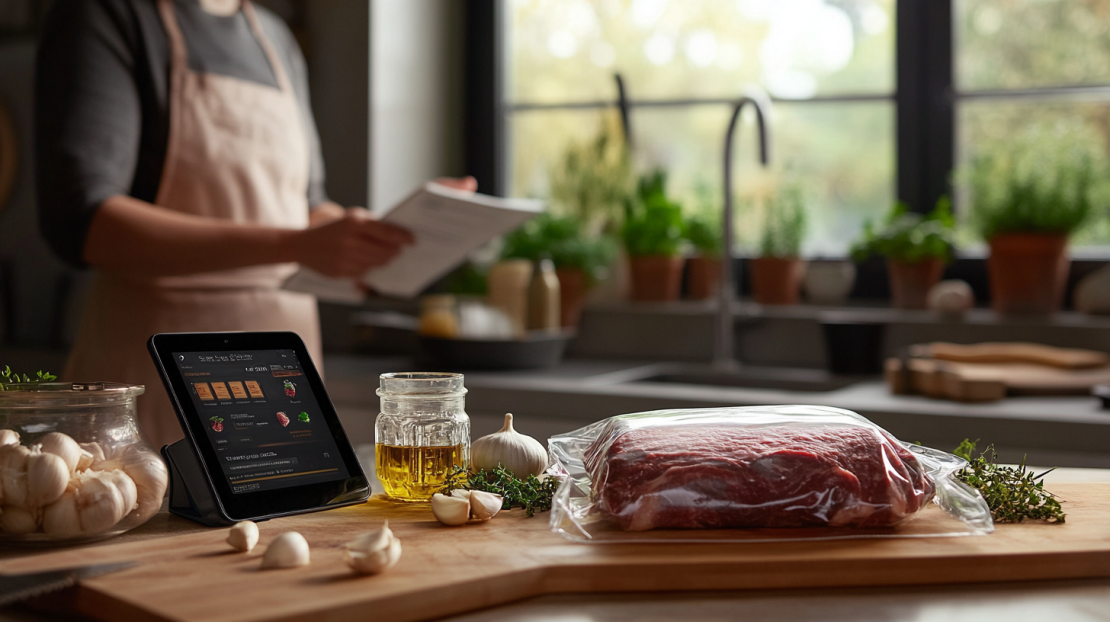The Ultimate Sous Vide Calculator Guide for Perfect Meals Every Time
Struggling to get your sous vide cooking just right? We know the feeling – overcooked or undercooked meals can be a real letdown. You want precision without guesswork. That’s where our sous vide calculator comes in.
This tool is designed to take the uncertainty out of sous vide cooking, ensuring your food is cooked perfectly every time. Let’s dive into how it works and why it’s a game-changer for your kitchen.
What Is a Sous Vide Calculator?
A sous vide calculator helps you determine the exact time and temperature needed to cook various foods using the sous vide method. It factors in the type of protein, its thickness, and your preferred doneness to give you accurate results.
Why Precision Matters in Sous Vide Cooking
When using sous vide, the consistency of temperature over time is what makes the difference. The sous vide method works by immersing food in a precisely controlled water bath, allowing even cooking without drying out or overcooking. Using a sous vide calculator ensures you get the perfect texture, whether it’s a juicy steak or tender chicken.
How to Use The Sous Vide Calculator
Step 1: Select Your Food Type
Begin by selecting the type of food you’re cooking. Our calculator offers a wide range of options:
- Beef (e.g., ribeye, filet mignon, short ribs)
- Pork (e.g., pork chop, pork belly, pork shoulder)
- Chicken (e.g., breast, thigh, whole chicken)
- Fish (e.g., salmon, tuna, cod, shrimp)
- Lamb (e.g., lamb chops, leg of lamb)
- Duck (e.g., duck breast, duck leg)
- Eggs (e.g., soft-boiled, poached, hard-boiled)
- Vegetables (e.g., carrots, broccoli, asparagus)
Each type has different cooking times and temperature settings to achieve the perfect result.
Step 2: Choose the Cut or Type
Once you’ve selected your food type, pick the specific cut or variety (e.g., ribeye for beef or salmon for fish). This allows the calculator to provide the most accurate cooking information tailored to that specific option.
Step 3: Enter the Thickness
Input the thickness of your selected cut. Thickness is a crucial factor in determining cooking time:
- For example, a 1-inch steak may cook in about an hour, while thicker cuts may need additional time.
- With pork, the thickness ensures the right balance of tenderness and juiciness, preventing undercooking.
Step 4: Select Your Doneness Level
Choose how you want your food cooked – options vary depending on the type. Common options include:
- Beef: Rare, medium-rare, medium, well-done
- Chicken: Tender, juicy, well-done
- Fish: Tender, flaky
- Eggs: Soft, custardy, firm
The calculator automatically adjusts time and temperature based on your preference. For instance:
- A medium-rare steak is typically cooked at 130°F (54°C) for about an hour.
- For chicken, you might select 150°F (65°C) for a juicy finish.
Step 5: Indicate If Frozen
Check the option if your meat or food is frozen. This adds extra time to the calculation, ensuring your food is cooked evenly despite its initial state.
Step 6: Calculate and Cook
After you’ve filled in all the details, click “Calculate.” The calculator will provide the exact cooking time and temperature needed. This way, you know when your food will be ready, and you can focus on other tasks or prep work while it cooks to perfection.
Sous Vide Calculator
Sous Vide Cooking Calculator
Popular Sous Vide Dishes and How the Calculator Helps
Sous vide is versatile, and the calculator makes cooking various dishes straightforward. Here are a few common dishes you can perfect with this tool:
Sous Vide Steak
Achieve the perfect steak every time. For a medium-rare ribeye, set your sous vide calculator to 130°F (54°C) and cook for about 1 to 1.5 hours. You can always finish it in a hot skillet for a crisp crust.
Sous Vide Salmon
Cooking fish requires a gentle touch. Set the calculator for 122°F (50°C) and cook the salmon for 45 minutes for tender, flaky results.
Sous Vide Pork Belly
Pork belly takes a bit longer. Use the calculator to set it at 165°F (74°C) and cook for up to 10 hours. The result? A tender, flavorful dish with just the right amount of fat.
Sous Vide Eggs
Whether you like your eggs soft, poached, or hard, a sous vide calculator ensures they turn out exactly how you want. A soft egg at 145°F (63°C) takes just 45 minutes.
Advanced Tips for Using a Sous Vide Calculator
Adjust for Frozen Foods
If your meat is frozen, add an extra 30 minutes to an hour to the cooking time. The calculator helps adjust this automatically, so you don’t have to guess.
Different Thickness Adjustments
Always measure your meat’s thickness accurately. Use a kitchen scale or a ruler to avoid miscalculations. The thickness directly affects cooking time and the texture of the final dish.
Post-Cooking Tips
Searing is a must for most proteins. Whether it’s a steak or pork, using a hot skillet after sous vide gives you a crispy exterior while keeping the inside juicy.
FAQs About Sous Vide Calculators
A sous vide calculator provides precise times based on scientific principles of sous vide cooking, making it extremely reliable.
Yes, though most calculators focus on proteins, some can also guide vegetable cooking times.
You can still use the sous vide calculator - just add extra time as recommended.
Yes, searing enhances flavor and creates a crispy texture.
Absolutely. It allows you to choose from rare to well-done settings.
Yes, if you follow proper temperature guidelines provided by the calculator.
Estimate as closely as possible. It’s best to round up to ensure proper cooking.
If you’re curious about other methods like steaming or boiling, see our guides on Mastering the Boiling Cooking Method and Steaming Cooking Method to expand your cooking skills beyond sous vide.
Closing Thoughts
With over 20 years of experience in commercial kitchens and as an executive chef, I know firsthand how important precision is in cooking. A sous vide calculator is not just a tool; it’s a game-changer for achieving consistently perfect results, whether you’re a seasoned pro or just starting with sous vide cooking. By following the guide above, you’ll take the guesswork out of sous vide, making your cooking not only easier but also more enjoyable.
If you want to keep learning and mastering new techniques, I invite you to subscribe to the Simply Delicious Digest, our newsletter by Edible Exposure Media. You’ll get exclusive recipes, tips, and the latest in culinary trends straight to your inbox. Sign up today at Simply Delicious Digest and take your cooking to the next level!


